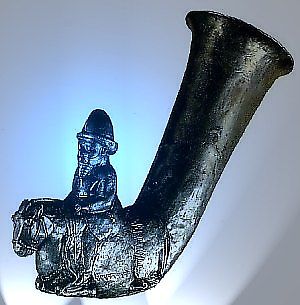
One of the most magnificent examples of art uncovered from Urartian times is this drinking vessel, showing an Urartian king or lord on a galloping horse. The overall design and helmet are unique in the Near East, reminiscent of that used for a fresco of an Urartian god (follows), though the representation of the beard links the vessel to Assyrian designs.
 Argishti
I Helmet
Argishti
I Helmet
Thought to have been worn by Sardur II in battle, the Sarduri helmet is an embossed bronze and metal piece with unique iconography. Eight (four on each side) snakes with lion heads curve over the entire design (guarding against evil spirits/souls) of eleven Trees of Life, deities, chariots and horsemen. The back of the helmet shows a picture of Urartian soldiers in chariots or on horses.
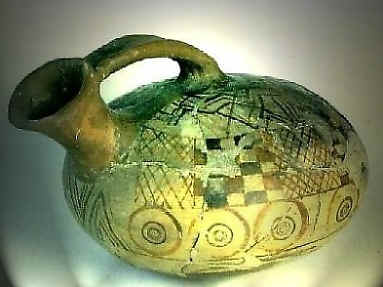 Vessel-Askos
Vessel-Askos
Teishebaini
(Karmir Blur-Yerevan)
8th-7th century BC
glazed pottery
Geometric vessels figure into Armenia's history at least to the 5th millennium BC, and reached a height of artistic achievement at Shengavit around 4000-3500 BC. The patterns are reminiscent of later works discovered at Mycanaean and Minoan excavations in the Mediterranean.
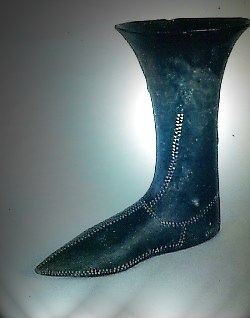 Boot
Vessel
Boot
Vessel
Unique in the artifacts found at Teishebaini is this boot vessel, realistically created with black and white clay, the white used to represent seams in the boot. It's use is unknown, though it may have representedthe boot of one of the gods, symbolizing power, and used at worship or banquets.
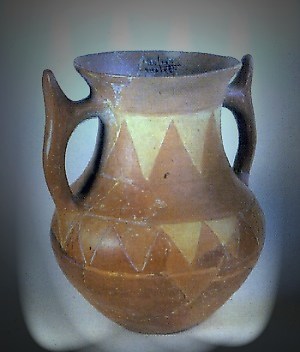 Red
Slipped Vessel
Red
Slipped Vessel
Red and black glaze was favored by Urartians, and is one of the distinguishing features of their ceramics. This vessel alternates two-toned red triangles (the white is part of the reconstruction), eight at the top, 14 at the bottom. Eight is a repetitive number in Urartian religious symbolism, representing eternity. The total of sixteen triangles can be made into its prime number 7, which was considered a sacred number.
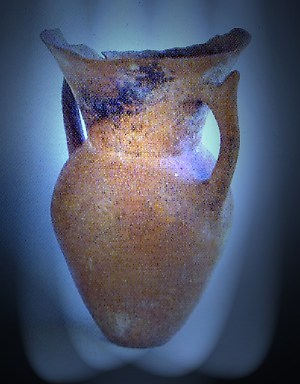 Ceramic
Jug
Ceramic
Jug
A simpler design was used for this vessel found at Erebuni. Erebuni was abandoned in the 6th century, its most important items removed to Teishebaini, where the bulk of artifacts were found. Those that remained were utilitarian items such as his jug, used to store oil, wine or water.
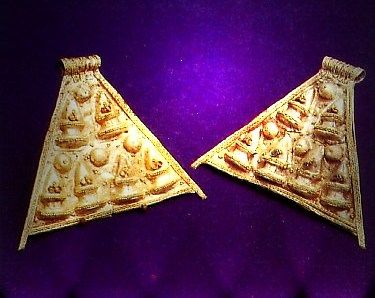
Each ring includes six human forms, four on the bottom row, two on the upper. Four granular half beads are interspersed between them, while finely detailed edgings frame the entire picture. The number 4 symbolized the cardinal directions and the seasons in ancient numerology, and these half-beads may mark the passage of time. Both earrings hold eight half-rounds and 12 humans, possibly an allusion to twelve tribes or cultures also referred to in Sumerian mythology.
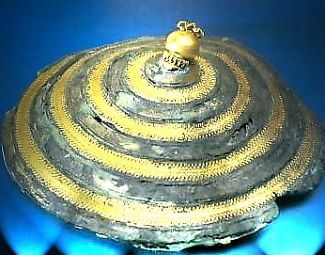 Pomegranate
Vessel Cover
Pomegranate
Vessel Cover 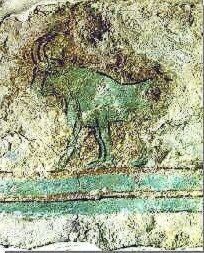 Fresco
of Bull
Fresco
of Bull
Erebuni
(Yerevan)
8th century BC
fresco and pigment
The bull may be a representation of one of Urartu's gods, symbolizing power and strength. The fragment was part of a decorative frieze found within the complex.
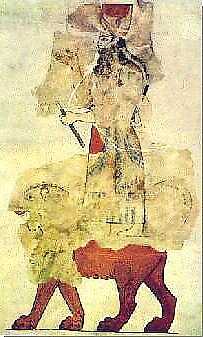
This reconstruction using fragments found in the palace complex in Erebuni depicts Khaldi, the main Urartian god. Urartians worshipped 79 gods and goddesses in its pantheon, most a combination of human and animal aspects. Khaldi is shown riding a lion, the rod of his authority on earth in one hand, the other raised in wisdom. His dress is similar to that found throughout the Near East and Assyria at the time, though the head dress is akin to Egyptian deities.

Teisheba was the Urartian god of war, and is shown holding weapons, wearing a helmet. Though made from bronze, the figure appears as polished mahogany. The figurine is small enough (24 cm) to have been used for personal use.
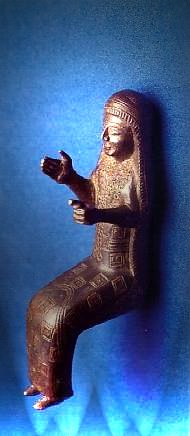 Statuette
of Arubani
Statuette
of Arubani
Arubani was the Urartian goddess of fertility and art, and the wife of Khaldi. This 12 cm. figurine is in a sitting position, and was probably placed in a small shrine on a chair or throne. Arubani is the Urartian equivalent to the Armenian goddess Anahit and the Greek goddess Artemis. The details on the figurine show eight side-squares with a four pointed star or water lily (native to Armenia) in the center, and a large chain and medallion on her chest. Silk fragments found in the temple precinct at Erebuni suggests larger statues were adorned with clothing of the finest materials.